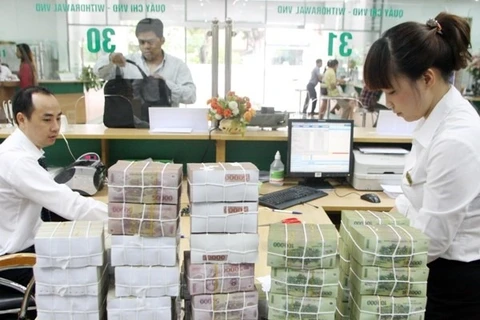Hanoi (VNA) – Credit institutions in which the State controls over 50 percent of charter capital will now be subject to assessment, according to a circular drafted by the Ministry of Finance.
The assessment will be based on five criteria: total revenue, after-tax profit and after-tax profit margin over equity, bad debt ratio and potentially irrecoverable debt ratio, observance of legal regulations and Government’s policies; and implementation of public utility products and services.
For the first criterion, the circular states that the total turnover is determined according to the balance in the bookkeeping accounts of the credit institution.
Under the second criterion, after-tax profit is the net profit from business activities after deducting expenses for provisioning risky loans and corporate income tax. The ratio of after-tax profit to the owner’s equity is determined by the percentage of after-tax profit divided by the average equity in the year.
For the third criterion, the draft regulates that the non-performing loan (NPL) ratio is the ratio of outstanding NPLs (including subprime debt, doubtful debt and potentially irrecoverable debt) against total outstanding loans (including standard debt, debt needing special attention, subprime debt, doubtful debt and potentially irrecoverable debt.
For the ratio of potentially irrecoverable debt, the draft circular states that it is the ratio of outstanding potentially irrecoverable loans to the total outstanding loans.
Debts in Vietnam are classified into five groups based on their risk status: standard debt, debt needing special attention, subprime debt, doubtful debt and potentially irrecoverable debt.-VNA
The assessment will be based on five criteria: total revenue, after-tax profit and after-tax profit margin over equity, bad debt ratio and potentially irrecoverable debt ratio, observance of legal regulations and Government’s policies; and implementation of public utility products and services.
For the first criterion, the circular states that the total turnover is determined according to the balance in the bookkeeping accounts of the credit institution.
Under the second criterion, after-tax profit is the net profit from business activities after deducting expenses for provisioning risky loans and corporate income tax. The ratio of after-tax profit to the owner’s equity is determined by the percentage of after-tax profit divided by the average equity in the year.
For the third criterion, the draft regulates that the non-performing loan (NPL) ratio is the ratio of outstanding NPLs (including subprime debt, doubtful debt and potentially irrecoverable debt) against total outstanding loans (including standard debt, debt needing special attention, subprime debt, doubtful debt and potentially irrecoverable debt.
For the ratio of potentially irrecoverable debt, the draft circular states that it is the ratio of outstanding potentially irrecoverable loans to the total outstanding loans.
Debts in Vietnam are classified into five groups based on their risk status: standard debt, debt needing special attention, subprime debt, doubtful debt and potentially irrecoverable debt.-VNA
VNA

























